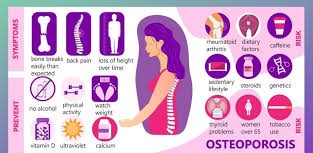Risk factors that increase the chance of getting “osteoporosis”
Risk factors that increase the chance of getting “osteoporosis”

In addition to bone cell abnormalities, there are many other factors that increase the risk of developing “osteoporosis.”
- Age: As we age, the body’s growth process slows down. Replacing worn out bones is also slow. Bone mass becomes fragile and easily broken, even if it receives a minor impact. If the body lacks the amount of calcium needed to build bones, it is at risk of osteoporosis.
- Gender: This disease occurs more often in women than men because when women enter menopause, the hormone estrogen decreases, causing bone mass to decrease as well. In men, there is a risk of osteoporosis when the production of testosterone decreases.
- Genetics: If someone in your family has a history of osteoporosis, you are at higher risk of developing osteoporosis than the general population.
- Disorders of the functioning of glands and organs such as the thyroid gland, parathyroid gland, adrenal gland, kidney and liver.
- Diseases and illnesses such as autoimmune diseases, rheumatoid arthritis, bone cancer
- Consumption: Eating foods that do not contain enough calcium to meet the body’s needs for bone building and growth, or eating foods that cause calcium to become imbalanced, such as protein foods from meat, which are highly acidic, as well as drinking large amounts of soft drinks, coffee, or alcoholic beverages regularly.
- Use of medications such as steroids, some anticonvulsants. If you need to use these medications for a long time, you should always consult your doctor first.
Possible complications of osteoporosis
The conditions that come with the word “osteoporosis” are quite worrying because when a patient has osteoporosis, it will result in:
- There is a high chance that the bone will break easily even if it receives a small impact.
- Patients will experience pain, difficulty moving, and greater limitations in performing daily activities, which can lead to depression.
- Patients who cannot walk or move with difficulty may develop pressure sores or urinary tract infections, which are serious complications that can lead to death.
Diagnosis of Osteoporosis… Early detection, treatment possible
“Osteoporosis” can happen to anyone. If abnormalities are detected early and treatment is initiated quickly, patients will have a better quality of life.
Diagnosis of osteoporosis is done by “radiological examination”. Which is a very effective method to assess bone mass density. Allowing doctors to plan treatment from the early stages of the disease. The examination does not take long, is painless, and uses low radiation.